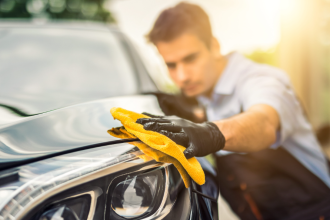John Deere is synonymous with high-quality agricultural and construction machinery. But besides tractors, harvesters, excavators, loaders and dozers, the company also produces a solid line of utility task vehicles. These are what the company calls XUVs, or crossover utility vehicles, ready for extensive use on farms, ranches, fishing and hunting grounds, golf courses, and regular duty on the construction site.
Where John Deere XUVs differ from the pack of more famous UTV names is the work-centric model range. Buyers have a choice of diesel, gas, and electric engines, 2WD, 4WD, and 6WD drivetrains, class-leading towing capacity, and exceptional cargo space. The Gator UTVs additionally feature standard extras that are hard to find anywhere else. This includes items like power bed lifts and standard receiver hitches, complemented with comfort additions ranging from full heating and AC control to hands-free steering with the proprietary Auto-track tech. The extensive lineup consists of ATVs and UTVs in different sizes, varying engine output, and seating for 4 passengers in bigger models.
While the practicality, versatility, and quality are there (JD produces UTVs for law enforcement, fire protection and paramedics) it suffers the same issues as prosumer-grade vehicles. Faulty or damaged axles and drive belts are common issues across all side-by-side makers, especially those geared for heavy-duty use. And they’re early warnings that something is wrong.
If you notice popping or clicking sounds in turns, or clunking noises when on the gas. then time for a new set of John Deere ATV axles. Aftermarket replacements are designed for precision fitment across old and new John Deere ATV and UTV models, ensure smooth power transfer and instil peace of mind with care-free driving.
Common Issues With Stock Axles
ATV and UTV axles transfer engine power through the transmission and drive belt down to the wheels. Without axles in working order, you’ll be going nowhere. The parts additionally support the weight of the vehicle, the driver, any included passengers and the load. They also enable steering and work with suspension components to negotiate obstacles and uneven terrain.
While no Gator models put out three-figure power numbers (gas-powered mid and full-sized models range between 32 and 54hp), they still produce ample torque. A bigger issue is the added load of various front and rear attachments, including spreaders, ploughs, winches, drawbars, and connected trailers.
To shift all that weight, axles need to work hard. They endure enormous amounts of heat and friction, resulting in gradual but consistent wear. Most reported issues are with the left and right front axles in older John Deere UTVs, often used in clearing snow and debris or with winches when hauling. While rear Gator axles have had fewer complaints, some have buckled under the weight of overloaded trailers.
Another common issue is the loss of grease through boot punctures. Grease lubricates internal bearings and splines ensuring smooth rotation and that engine power reaches the wheels. Leaked or contaminated grease increases the friction of metal on metal parts, causing the axles to seize, bend, or snap in two. Punctured boots also allow debris, water and dust to corrode the joints, with loss of power the first sign. Your stock John Deere drive axles may be better built than the completion, but they will eventually need replacing.
Why Choose Aftermarket Options
Torn CV boots, shattered bearings, and seized shafts are commonly reported issues with stock Gator axles. To get your money’s worth, aftermarket axles offer more quality, more robust builds, and higher grade materials. And they are sold with longer warranties and industry certification to ensure they last.
Most aftermarket brands offer several types of pre-assembled axles, meant for different applications. Heavy-duty options consist of thicker steel shafts to better deal with increased torque or higher weight loadings, specifically for the demanding work purposes that the John Deere Work and XUV series are marketed. They also deal with trail oscillations and harshness to offer a more comfy ride. Thick shafts are paired with flexible and puncture-resistant neoprene boots, packed with high-temperature Moly grease to reduce friction and wear in the joints, and roll on industrial bearings.
Sizeable machines, such as the XUV590M or the even bigger and more capable XUV835E, benefit from extreme-duty John Deere ATV axles. Here shafts are considerably thicker than stock, are made of heat and corrosion-resistant 4340 Chromoly steel, use heat-treated bearings for even higher weight and torque loadings, and rotate around CNC-machined CV joints for smoother power transfer. The shafts and joints are lubricated by the same heat-resistant grease, and covered with thicker boots. The quality build endures more abuse in typical work purposes at the construction site or farm and gets your Gator effortlessly across uncharted territory when hunting, fishing, or when you’re belting the throttle full out on technical trails.
When to Replace Axles
So, when do you swap out damaged or ailing John Deere Gator axles? Your quad will show noticeable signs that the axles, CV boots and joints need maintenance or have to be swapped out for a new set. I picked up on some of the most common symptoms – popping and clicking sounds when turning, and audible clunks when pressing the gas. Additional symptoms are vibrations caused by worn inner and outer joints; humming or buzzing sounds, usually from bad bearings, or ruptured boots and leaked grease; and the UTV pulling to the side in the straights.
Tears in CV boots caught on time can mean you’ve saved yourself some serious cash. Water, debris and leaking grease cause an increase in metal-on-metal friction and deal the biggest blow to the CV joints. Issues like these are easy to pick up in regular inspections. If you notice torn or punctured boots, but the shafts and joints don’t shout at you in different voices, the easiest repair is putting in a boot repair kit. Otherwise, you’ll be shelling out quite a bit more for a full assembly.
Replacement axles for any John Deere UTV are sold as separate right and left fronts and rears. Most drivers choose to get pairs to prevent possible performance issues when pairing a new axle on one side with a near-worn axle on the other. There are also front and rear pairs that come out a bit cheaper. Whatever you choose, having a spare around means more time for work, and that your Gator ATV or UTV works as it should.













